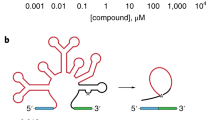Abstract
The alarming increase in drug resistance gained by fungal pathogens has raised an urgent need to develop drugs against novel targets. Candida albicans, an opportunistic fungal pathogen, harbors in its 25S rRNA gene, a self-splicing Group I intron, which can act as a selective drug target. We report that Bleomycin selectively inhibits the self-splicing of Group I intron of C. albicans at IC50 = 1.2 μM, leading to accumulation of precursor RNA as evinced by Reverse Transcriptase PCR. Drug susceptibility assays including MIC determination, growth curve analysis and disc diffusion assays indicate a strong susceptibility of the intron-containing strain (4-1) than the intronless strain (62-1). These results on the preferential targeting of Group I intron of C. albicans by Bleomycin might form a basis for design of small molecules that inhibit self-splicing of RNA as a antimicrobial tool against life-threatening microorganisms.




Similar content being viewed by others
References
Berry DE, Chang LH, Hecht SM (1985) DNA damage and growth inhibition in cultured human cells by bleomycin congeners. Biochemistry 24:3207–3214
Boucher HS, Mercure S, Montplaisir S, Lemay G (1996) A novel group I intron in Candida dubliniensis is homologous to a Candida albicans intron. Gene 180:189–196
Carter BJ, De Vroom E, Long CE, Van der Marel G, Van Boom JH., Hecht SM (1990) Site-specific cleavage of RNA by Fe(II) bleomycin. Proc Natl Acad Sci USA 87:9373–9377
D’ Andrea AD, Haseltine WA (1978) Modification of DNA by Aflatoxin B1 creates alkali-labile lesions in DNA at positions of guanine and adenine. Proc Natl Acad Sci USA 75:3608–3612
Disney MD, Childs JL, Turner DH (2004) New approaches to targeting RNA with oligonucleotides: Inhibition of group I intron self-splicing. Biopolymers 73:151–161
Embley TM, Dyal P, Kilvington S (1992) A group I intron in the small subunit ribosomal RNA gene from Naegleria andersoni ssp. andersoni strain PPMF-6. Nucleic Acids Res 20:6411
Fire A, Xu S, Montgomery MK, Kostas SA, Driver SE, Mello CC (1998) Potent and specific genetic interference by double stranded RNA in Caenorhabditis elegans. Nature 391:806–811
Gast RJ, Fuerst PA, Byers TJ (1994) Discovery of group I introns in the nuclear small subunit ribosomal RNA genes of Acanthamoeba. Nucleic Acids Res 22:592–596
Graybill JR, Bocanegra R, Fothergill A, Rinaldi MG (1996) Bleomycin therapy of experimental disseminated candidiasis in mice. Antimicrob Agents Chemother 40:816–818
Haidle CW, Bearden J Jr (1975) Effect of bleomycin on an RNA–DNA hybrid. Biochem Biophys Res Commun 65:815–821
Hecht SM (1986) The chemistry of activated bleomycin. Acc Chem Res 19:383–391
Krishnamoorthy CR, Vanderwall DE, Kozarich JW, Stubbe J (1988) Chemistry of bleomycin attack on DNA–RNA hybrids and DNAs. J Am Chem Soc 110:2008–2009
Liu Y, Leibowitz MJ (1993) Variation and in vitro splicing of group I introns in rRNA genes of Pneumocystis carinii. Nucleic Acids Res 21:2415–2421
Mehta R, Champney WS (2002) 30S ribosomal subunit assembly is a target for inhibition by aminoglycosides in Escherichia coli. Antimicrob Chemother 46:1546–1549
Mercure S, Cousineau L, Montplaisir S, Belhumeur P, Lemay G. (1997) Expression of a reporter gene interrupted by the Candida albicans group I intron is inhibited by base analogs. Nucleic Acids Res 25:431–437
Mercure S, Montplaisir S, Lemay G (1993) Correlation between the presence of a self-splicing intron in the 25S rDNA of C. albicans and strains susceptibility to 5-fluorocytosine. Nucleic Acids Res 21:6020–6027
Miletti KE, Leibowitz MJ (2000) Pentamidine inhibition of group I intron splicing in Candida albicans correlates with growth inhibition. Antimicrob Agents Chemother 44:958–966
Moazed D, Noller HF (1987) Interaction of antibiotics with functional sites in 16S ribosomal RNA. Nature 327:389–394
Ogle JM, Brodersen DE, Clemons WM Jr, Tarry MJ, Carter AP, Ramakrishnan V (2001) Recognition of cognate transfer RNA by the 30S ribosomal subunit. Science 292:897–902
Pearson ND, Prescott CD (1997) RNA as a drug target. Chem Biol 4:409–414
Sogin ML, Edman JC (1989) A self-splicing intron in the small subunit rRNA gene of Pneumocystis carinii. Nucleic Acids Res 17:5349–5359
Sternberg S (1994) The emerging fungal threat. Science 266:1632–1634
Stubbe J, Kozarich JW (1987) Mechanism of bleomycin induced DNA degradation. Chem Rev 87:1107–1136
Takeshita M, Grollman AP, Ohtsubo E., Ohtsubo H (1978) Interaction of Bleomycin with DNA. Proc Natl Acad Sci USA 75:5983–5987
Vicens Q, Westhof E (2001) Crystal structure of paromomycin docked into the eubacterial ribosomal decoding A site. Structure (Cambridge) 9:647–658
Von Ahsen U, Davies J, Schroeder R (1991) Antibiotic inhibition of group I ribozyme function. Nature 368:368–370
Von Ahsen U, Davies J, Schroeder R (1992) Non-competitive inhibition of a group I intron RNA self-splicing by aminoglycoside antibiotics. J Mol Biol 226:935–941
Von Ahsen U, Schroeder R (1991) Streptomycin inhibits splicing of group I introns by competition with the guanosine substrate. Nucleic Acids Res 19:2261–2265
Vormann J (2003) Magnesium: nutrition and metabolism. J Mol Aspects Med 24:27–37
Wank H, Rogers J, Davies J, Schroeder R (1994) Peptide antibiotics of the tuberactinomycin family as inhibitors of group I intron RNA splicing. J Mol Biol 236:1001–1010
Acknowledgement
We sincerely thank Dr. G. Jayaraman, Dept. of Genetics, University of Madras for his valuable suggestions and for providing gel documentation facilities.
Author information
Authors and Affiliations
Corresponding author
Rights and permissions
About this article
Cite this article
Jayaguru, P., Raghunathan, M. Group I intron renders differential susceptibility of Candida albicans to Bleomycin. Mol Biol Rep 34, 11–17 (2007). https://doi.org/10.1007/s11033-006-9002-1
Received:
Accepted:
Published:
Issue Date:
DOI: https://doi.org/10.1007/s11033-006-9002-1




